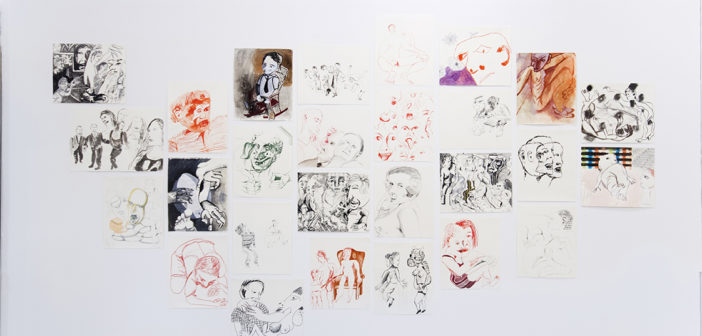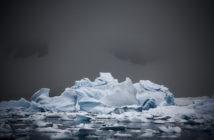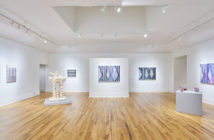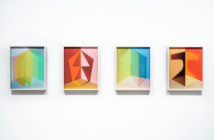At first glance, The Split, curated by Amanda Schmitt, feels schizophrenic. The works span media from video to drawing, painting, sound, and sculpture and a diagonal wall physically extenuates the mental dissonance. At first, it is very tempting to read the wall as the split after which the exhibition is titled and to try and find a pattern as to which works belong on which side. But as guest curator, Schmitt reassures in her curatorial statement that the divide is much deeper than it first appears.
On the gallery’s desk is a well-worn copy of The Primal Scream, Primal Therapy: The Cure for Neurosis by Arthur Janov, Schmitt’s inspiration for this grouping. The exhibition title and concept come from a quote from Janov in which he states, “This separation of oneself from one's needs and feelings is an instinctive maneuver in order to shut off excessive pain. We call it the split. The organism splits in order to protect its continuity.”
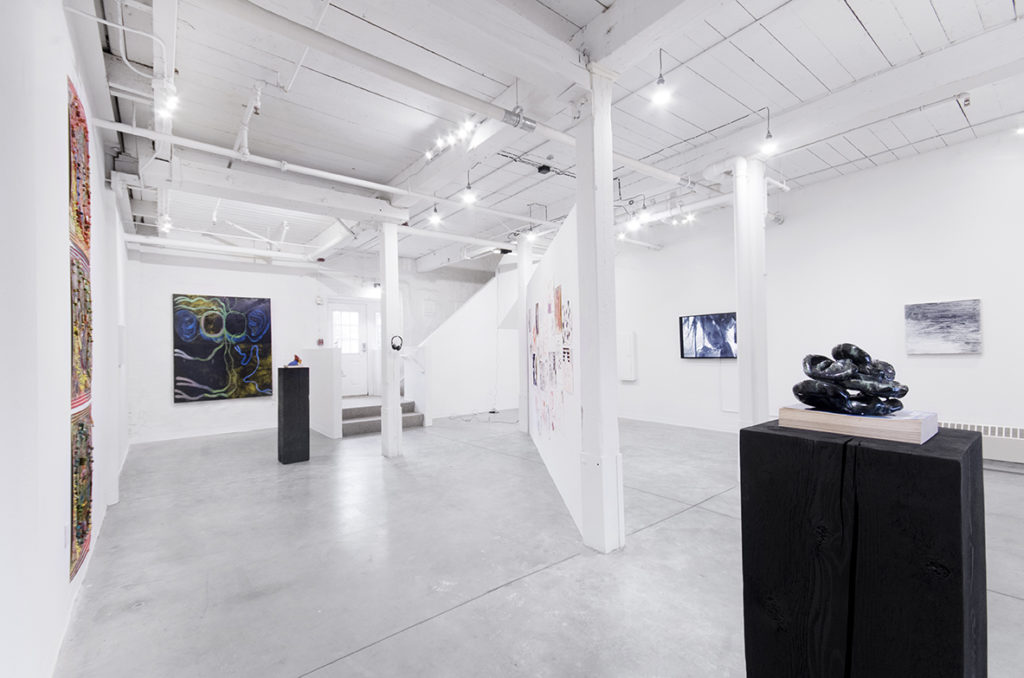
Installation of The Split curated by Amanda Schmitt
Image courtesy of GRIN
Schmitt readily admits that her role is not as analyst of the artists that she has curated here. And this is where the dance between artist and curator becomes its most complicated. In an interview with Jamilee Lacy of Providence College Galleries, Schmitt parses her role as curator and of the role of mental health in art. Using Janov’s text she has drawn a line between “real needs” and perceived but “unreal needs”. This is the criteria that have perhaps also drawn a line through the gallery itself with artists on one side whose work is a real need: the feels that must be expressed and released through creative output, such as the haunting drawings of Sofi Brazzeal. And the “unreal needs”: the compulsions that point to “real needs” that are not being met, like Jacob Loebs desire to record the results of 500 dice rolls in beyond the decapitated.
Upon closer examination, however, the easy to digest dichotomy of the divided room is satisfyingly upset by outliers like Dawn Kasper’s scrawled graphite and acrylic work, Chance Operation, which feels like a cathartic exercise in image making. And on the side that was seemingly reserved for the “real needs” the expressions emoted through image and object, are the playful ink drawings of Ebecho Muslimova, in which a nude and comically grinning woman performs childish antics with mundane architectural elements like a sliding glass window or a large vent. The interview reveals this character to be the artist’s alter ego and through her, these impulsive acts are performed, a bit of the “unreal need” manifesting itself by proxy.
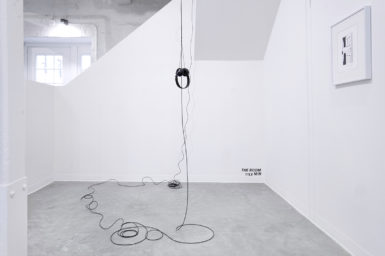
Installation of The Split curated by Amanda Schmitt
From Left: the roomo by Sarah Kurten, Fatebe Opens Doos by Ebecho Muslimova
Image courtesy of GRIN
The second sound piece was more difficult to reckon with the whole. It is hard to listen to both sound pieces together, and given my impression of Appel’s piece, it was a much more difficult weave in Sarah Kurten’s In a Room. In some ways it is the opposite, almost a guided meditation for the exhibition with its repeated mantra that you are in a room and the room is empty. It feels like a reassurance that this room, that is by no means empty, is just mental state, all those traumas that these arts have split from, are all in their heads. They can be released, coped with.
For an exhibition bound by the artists’ psyches, their mental states, the ghosts in the attic, there are a surprising number of figurative works, from Nicolas Guagnini’s ceramic sculptures, featuring ears and a foot and Michel Auder’s video of a child talking to herself to the more abstract gestural works of Kasper and Loeb’s compulsive documentation of his dice rolls, both of which serve as a record of the artist's action. Even Davia Semo’s quiet sculpture waffling between floor tile and cushion, is titled in such a way to evoke a physical sensation, HOLDING HER FACE BETWEEN HER HANDS, SHE MAKES A SOUND.
The Split is an exhibition of divisions: between mind and body, chaos and order, past traumas and present reactions. Its schizophrenia is natural, and it is dealt with care and almost compassion. Each piece is allowed to be itself, whether it's compulsive, neurotic, repressed or almost literally, a primal scream.
The Split at GRIN, guest curated by Amanda Schmitt, is now on view until May 20th.

